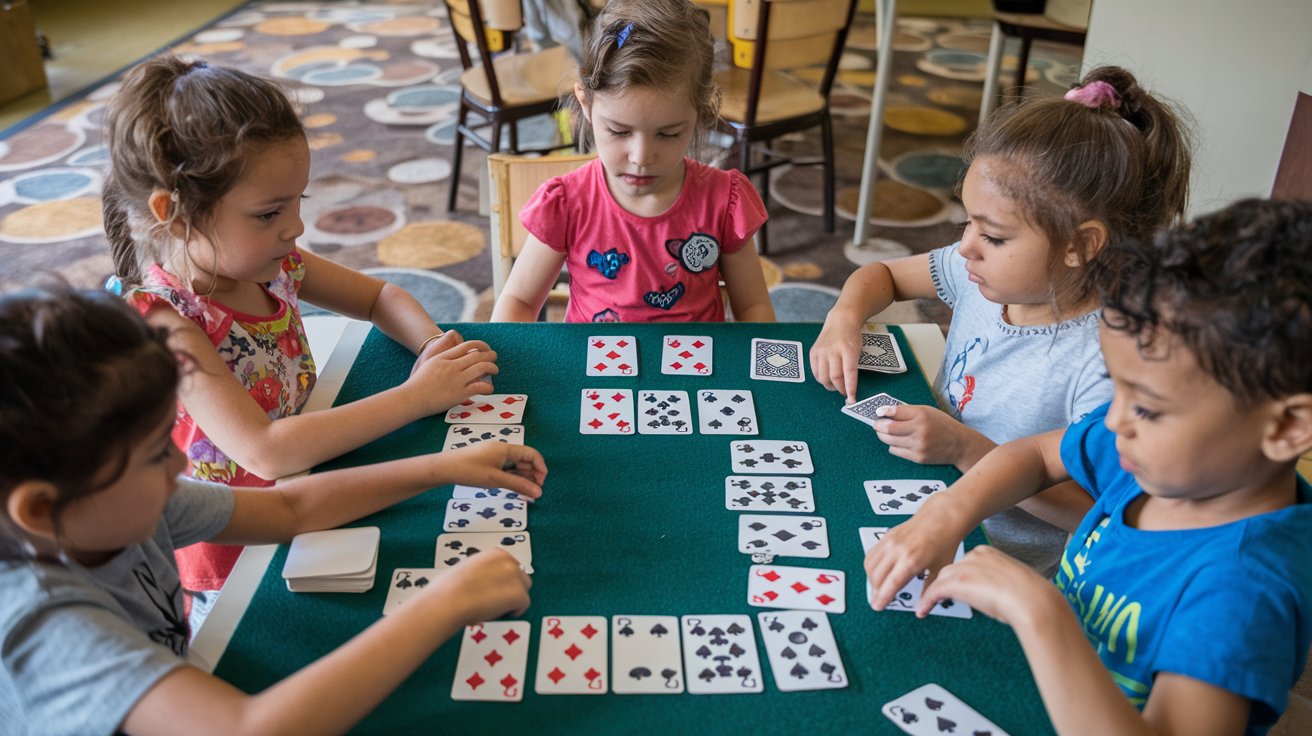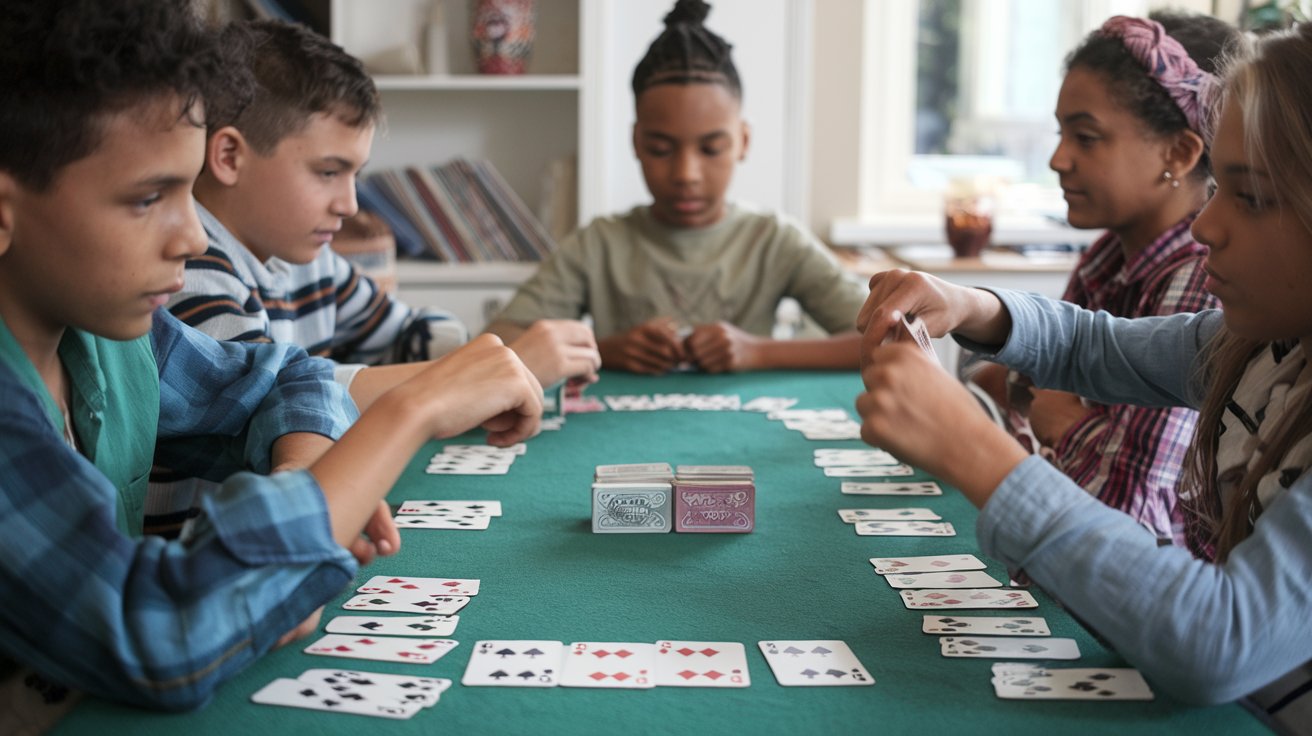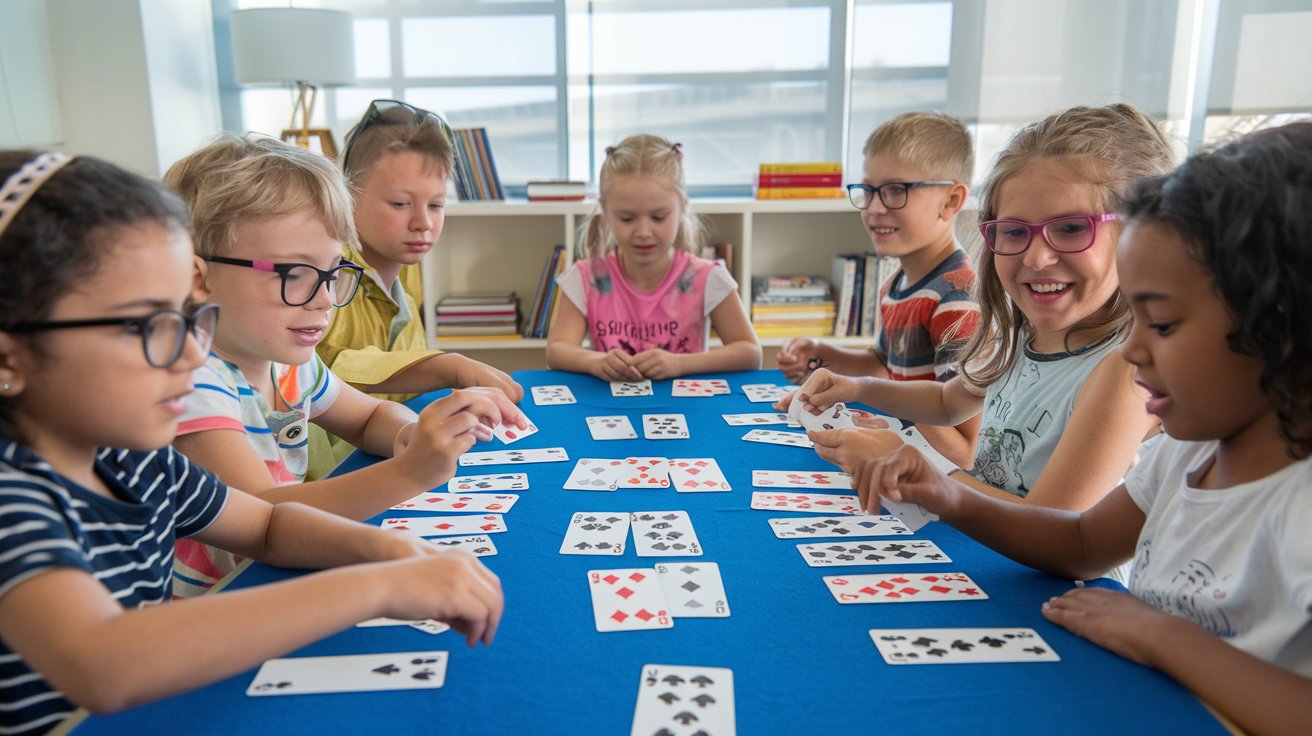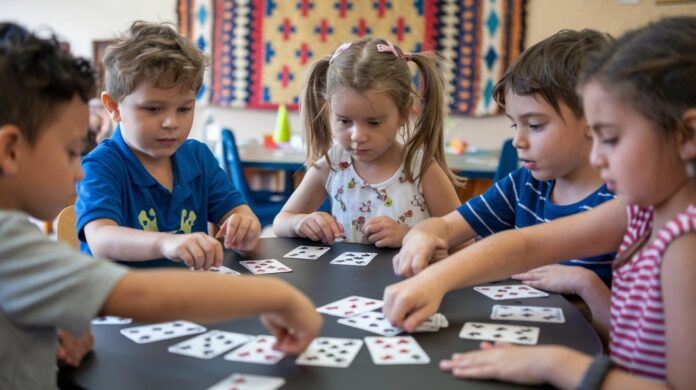Teaching card games to children is a wonderful way to build cognitive skills while creating lasting family memories. Rummy, with its perfect blend of strategy and accessibility, stands out as an ideal game for young players. This comprehensive guide will walk you through the process of introducing Rummy to children, with age-appropriate strategies, simplified rules, and fun variations that will keep kids engaged and excited to play.
Why Rummy Is Perfect for Children

Before diving into teaching methods, it’s worth understanding why Rummy is particularly well-suited for younger players:
Educational Benefits
Rummy offers numerous developmental advantages for children:
- Math skills: Children practice counting, sequencing, and basic addition
- Memory development: Remembering discarded cards and tracking other players’ possible combinations
- Pattern recognition: Identifying runs and sets builds cognitive pathways
- Strategic thinking: Planning ahead and making decisions based on probability
- Concentration: Maintaining focus throughout the game strengthens attention span
- Social skills: Taking turns, following rules, and practicing good sportsmanship
Age-Appropriate Fun
Unlike many complex card games, Rummy can be easily adapted for different age groups, making it enjoyable for the whole family. The satisfaction of making matches appeals to children’s natural desire to create order and recognize patterns.
Determining if Your Child is Ready for Rummy

While Rummy can be adapted for various ages, certain developmental milestones make learning the game easier:
Signs of Readiness
Look for these indicators that your child might be ready to learn Rummy:
- Basic counting abilities: They should be comfortable counting to at least 10
- Number recognition: Ability to identify numbers on cards
- Attention span: Can focus on an activity for at least 15-20 minutes
- Basic sequencing skills: Understands concepts like “next” and “before”
- Hand coordination: Can hold and organize several cards independently
Most children between 6-8 years old will have these skills, though some younger children may be ready sooner. For very young children (4-5 years), consider starting with modified versions outlined later in this guide.
Preparing to Teach: Setting Up for Success

Before dealing the first hand, prepare the environment and materials for an optimal learning experience:
Creating the Right Environment
- Choose a distraction-free setting: Turn off screens and find a quiet space
- Ensure comfortable seating: Everyone should be able to reach the playing area easily
- Good lighting: Cards should be clearly visible
- Appropriate timing: Select a time when your child is alert and not hungry or tired
- Positive atmosphere: Approach teaching as fun, not a serious lesson
Materials Needed
Gather these items before starting:
- One standard deck of cards: Consider larger-print cards for younger children
- Card holders: Plastic stands help little hands manage multiple cards
- Point tracker: A simple notepad or whiteboard for scoring
- Visual aid: A printed cheat sheet showing valid combinations
- Snacks and drinks: Keep energy levels up during play
Step-by-Step Teaching Guide
Follow this structured approach to introduce Rummy to children:
Step 1: Introduce the Card Families
For complete beginners to card games, start with basics:
- Explore the deck: Show the four suits (hearts, diamonds, clubs, spades)
- Identify card values: Explain number cards and face cards
- Sort by groups: Have them sort cards by suit or number as practice
- Card handling: Demonstrate how to hold cards in a fan formation
Step 2: Explain the Goal in Child-Friendly Terms
Use simple language to describe the objective:
“In Rummy, we’re trying to make special groups with our cards. We can make a group of the same number, like three 7s. Or we can make a line of cards that go in order, like 4-5-6 of the same suit. The first person to group all their cards wins!”
Step 3: Teach the Basic Rules (Simplified Version)
Start with a streamlined version of Rummy:
- Deal cards: 5-7 cards for beginners (fewer cards are easier to manage)
- Place remaining deck: Put the deck face-down as the draw pile
- Start discard pile: Turn one card face-up beside the draw pile
- Explain turns: On each turn, take one card and discard one card
- Show valid combinations:
- Sets: Three or four cards of the same rank (e.g., three 8s)
- Runs: Three or more consecutive cards of the same suit (e.g., 5-6-7 of hearts)
- Winning: The first player to form all their cards into valid combinations wins
Step 4: Play an “Open Hand” Practice Round
For the first few games, try these training approaches:
- Cards face-up: Everyone plays with cards visible
- Collaborative play: Adults can suggest moves without playing competitively
- Explain choices: Narrate your decision-making process
- Praise attempts: Recognize when children identify potential combinations
Step 5: Introduce Strategy Gradually
Once basic play is understood, introduce simple strategies:
- Card organization: Teach children to arrange cards by suit or number
- Watching discards: Point out why certain discards might be valuable
- Planning ahead: Suggest looking for cards that could work in multiple combinations
- Defensive play: Explain basic concepts of not discarding cards others might need
Age-Specific Adaptations
Tailor your approach based on the child’s age:
For Ages 4-5: “My First Rummy”
For preschoolers, use these simplifications:
- Reduced cards: Use only number cards 1-10, removing face cards
- Smaller hands: Deal 3-5 cards per player
- Simplified combinations: Only require pairs or three of a kind (no runs yet)
- Visual cues: Use colored sorting trays to help organize cards
- Team play: Young children can pair with adults initially
For Ages 6-8: “Junior Rummy”
Elementary school children can handle more complexity:
- Standard deck: Include face cards but consider removing kings
- Moderate hands: Deal 5-7 cards per player
- Basic combinations: Introduce both sets and runs
- Scoring: Introduce simple scoring without card values (e.g., 1 point per set or run)
- Memory practice: Encourage remembering which cards have been discarded
For Ages 9+: “Standard Rummy”
Older children can play close to regular rules:
- Full deck: Use all cards including face cards
- Regular hand size: Deal 7-10 cards
- Complete combinations: Teach both sets and runs with proper validation
- Point system: Introduce standard Rummy scoring
- Strategy discussions: Talk about more advanced tactics between games
Fun Variations to Keep Kids Engaged
Maintain interest with these child-friendly Rummy variations:
Rummy Race
A faster-paced version perfect for shorter attention spans:
- Deal smaller hands (5 cards)
- First player to create any valid combination (one set or run) wins that round
- Play multiple quick rounds and keep a running score
Rainbow Rummy
Add a colorful twist:
- Focus on creating “rainbow sets” with one card of each suit of the same value
- Assign bonus points for rainbow sets to encourage suit diversity
- Use actual colored tokens to represent different suits for visual learners
Story Rummy
Combine storytelling with gameplay:
- When a player creates a combination, they must tell a brief story using that number
- For example, three 7s might inspire a story about “7 tiny dragons…”
- The most creative story wins bonus points
Team Rummy
For family play with mixed ages:
- Create teams with one child and one adult
- Players can whisper strategy to their teammates
- Take turns making decisions, allowing children to learn from adults’ choices
Common Challenges and Solutions
Address these typical hurdles when teaching kids:
Challenge: Difficulty Holding Cards
Solutions:
- Use plastic card holders or stands
- Arrange cards on the table instead of holding them
- Try jumbo-sized playing cards for small hands
Challenge: Confusion About Valid Combinations
Solutions:
- Create a visual reference card with examples
- Use highlighters to mark potential matches in practice games
- Draw diagrams showing valid and invalid groupings
Challenge: Short Attention Span
Solutions:
- Play shorter rounds with fewer cards
- Take breaks between hands
- Incorporate physical movement (stand up and stretch) between turns
- Use a timer to keep turns moving quickly
Challenge: Frustration When Losing
Solutions:
- Focus on improvement rather than winning
- Highlight good plays regardless of the game outcome
- Implement a “lucky card” rule where one wild card is allowed
- Play collaboratively until confidence builds
Making Learning Memorable
Enhance the experience with these engagement strategies:
Create Rummy Rituals
Establish special traditions around game time:
- Designate a special “game night” with Rummy as the featured activity
- Create a “dealer’s choice” rule where the dealer gets to select the Rummy variation
- Have a special snack that’s only served during card games
- Use a special tablecloth or placemat for card games
Reward Progress
Acknowledge development without focusing solely on winning:
- Create a “Rummy Skills” chart where new abilities can be checked off
- Award “strategy stars” for particularly clever moves
- Take photos of impressive card combinations for a “Rummy Hall of Fame”
- Celebrate the first time a child wins a game independently
Connect to Other Learning
Extend the educational benefits:
- Practice multiplication by calculating scores
- Explore probability by discussing the chances of drawing needed cards
- Develop vocabulary by requiring players to use descriptive words when playing
- Discuss the history of card games and their cultural significance
Conclusion: Building Skills and Memories
Teaching Rummy to children offers far more than just an entertainment option for rainy days. It provides a framework for developing critical thinking, mathematical reasoning, and social skills in a format that children find genuinely enjoyable. By adapting the game to suit your child’s developmental stage and maintaining a positive, pressure-free environment, you’ll lay the groundwork for a lifetime of strategic thinking and family bonding.
Remember that the ultimate goal isn’t creating card game prodigies but fostering a love of learning, problem-solving, and quality time together. With patience and the right approach, your young Rummy player will soon be surprising you with their combinations and strategies—and perhaps even beating you fair and square!
So shuffle the deck, deal the cards, and embark on this rewarding journey of teaching one of the world’s most beloved card games to the next generation of players.

Zareb Saleh is a journalist at Gulf Today and a ghostwriter for Gameoholic, specializing in gaming, technology, and digital culture. With a keen eye for industry trends, he delivers insightful stories that engage and inform readers.




